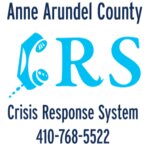Clear, 79°
Wind: mph,



Every 11 minutes, someone in the United States dies by suicide, totaling 48,183 Americans in 2021 according to the Centers for Disease Control. Estimates from the National Institute of Mental Health indicate that more than one in five U.S. adults live with a mental illness, representing over 57 million people. About as many Americans over the age of 12 faced a substance use disorder in 2022, including 29.5 million who had an alcohol use disorder and 27.2 million who had a drug use disorder, according to the Substance Abuse and Mental Health Services Administration.
These statistics represent real people of all ages, ethnicities and backgrounds, and impact almost every American, whether personally or among friends and family. With a population of over 588,000 residents, Anne Arundel County is represented among these numbers; in 2020, suicide was among the top 10 causes of death according to the county’s 2022 Health Report Card.
Locally and nationally, the need for mental and behavioral health intervention is great. In Anne Arundel County, individuals facing these challenges have somewhere to turn.
Established in 1999, the Anne Arundel County Crisis Response System (CRS) exists to provide person-centered assistance to people in the community facing mental health or substance use crises. While people experiencing these types of crises traditionally have been treated in emergency rooms or have become incarcerated, the CRS was developed to serve individuals in the least restrictive setting, providing an array of behavioral health supports for individuals in distress.
County residents can receive real-time mental health and substance use disorder support 24/7/365 by calling CRS’ crisis warmline at 410-768-5522. It is important to note, however, that if there is a concern for safety and a need for an immediate response, residents should always call 911 for emergency situations. In Fiscal Year 2023, warmline operators fielded 35,467 incoming calls from across the county, including 4,409 calls placed by youth.
Anne Arundel County Crisis Response System Director Jen Corbin explained that residents can call the warmline for a variety of needs including but not limited to behavioral health. “We really want to be the catch-all for the county, so there’s really no wrong call,” Corbin said. “Someone may call because they’re uninsured or at risk of homelessness, but then there’s people who call in for ‘I’m feeling like I’m struggling with my mental health and I’m having thoughts of suicide.’”
Corbin, who has headed CRS for over a decade, explained that the Crisis Response System serves people in three primary ways. The first is through mobile crisis teams, which are activated through police radios when behavioral health is the primary concern, and consist of a licensed clinician and a master’s level clinician. “I call it therapy on wheels,” Corbin said, adding, “It’s basically clinicians coming out to you to start that process and help be supportive until someone is connected to the resource they need.” In Fiscal Year 2022, mobile crisis teams were dispatched 3,126 times.
For more intense situations, CRS sends crisis intervention teams consisting of an Anne Arundel County police officer and a licensed clinician, both trained in crisis intervention. These teams are equipped to respond to situations that mobile crisis teams cannot, such as when weapons or barricades are involved, or as first arrivals at schools until guardians can be reached. Crisis intervention teams conducted 372 assessments in FY22.
Initiated in 2017, CRS’ Safe Stations program makes it possible for individuals dealing with substance use disorders who are ready for treatment to walk into any county police or fire station and request assistance. If an individual is not in need of immediate medical attention, CRS can then dispatch someone to help them get connected to substance treatment options. In FY23, 690 individuals obtained help for substance use through the Safe Stations program.
The support offered by CRS to thousands of county residents every year does not end with an initial call or visit. In FY22, care coordinators completed 22,527 follow-up calls and had 4,073 face-to-face interactions with individuals and families.
Corbin emphasized that the heart of the CRS is to meet people who are at crisis level and return them to pre-crisis levels. “I always say my ultimate goal is to take the word ‘crisis’ out of the crisis system and be able to get people linked to the services they need so they’re not in crisis,” she said. “So a lot of times when we’re going out, it’s, ‘What can we do today to help you not need to go to the hospitals?’ What can we do to help you not lose your housing?’ It’s all of those things.”
Anne Arundel County’s CRS is hailed as one of the most advanced in the state and country for its innovative approach and critical partnerships with other county agencies. Corbin explained that CRS does not stay stagnant in what it does; instead, she and her team continually evaluate new situations not just in the county but across the U.S. and try to get ahead of those issues so they are prepared to best serve county residents. Over the years, these areas of focus have evolved from repeat hospital visits to homelessness to the opioid epidemic to threat assessments, among other issues.
This approach is possible because of highly cooperative partnerships with other county agencies including police, fire, the hospitals, the department of social services, the department of aging and the school system.
CRS’ collaboration with the police department sets them apart from many similar agencies. “Across the U.S. they’re talking about putting clinicians in the police department. That’s not what we need to do,” Corbin said. “We need to put police in with clinicians, and what our police department has committed to is we have eight officers, a lieutenant and a sergeant who are housed here at crisis. So the communication starts from the time the call comes into the warmline to the dispatch to the completion of the call that allows the officer to think differently. It allows them to be prepared going into the call, and to really have an ability to look at the call from many different perspectives, not just the police perspective, and that’s really what’s changing what we do in the county.”
Corbin also noted that Anne Arundel’s CRS is focused on the wellbeing of these responding officers. “We see officers as just officers; they’re also significant others, they’re parents, they’re someone’s child,” she said, noting that her team sits down and processes difficult calls with officers after the fact. “These calls impact them too. We pride ourselves on a culture of caring within the police department. If we’re not developing a culture of helping within the police department, how do we ask them to go out and help the community?”
Corbin credited the CRS staff team for much of the program’s success. Clinicians, warmline operators, care coordinators and others are available every day of the year including holidays, and they often face stressful and sometimes dangerous situations, she noted. “We are first responders – everybody always talks about fire, police, the hospitals – yet we did everything through COVID and these guys never backed down,” she said of her colleagues.
“We’re a really good team and everybody is committed to wanting to help our county residents,” Corbin said.
To learn more about Anne Arundel County’s Crisis Response System, go to www.aamentalhealth.org. To obtain assistance in a crisis situation, call the warmline at 410-768-5522.
Comments
No comments on this item Please log in to comment by clicking here